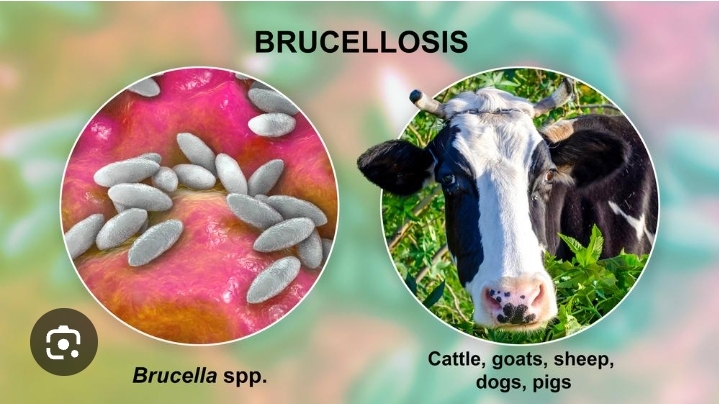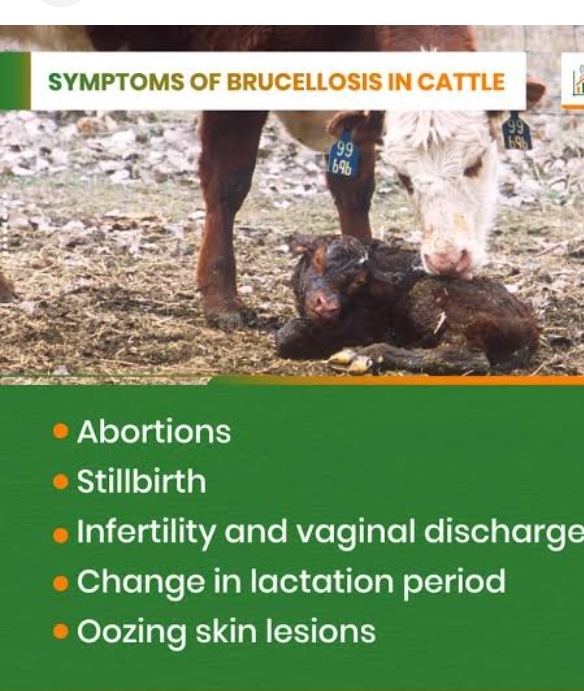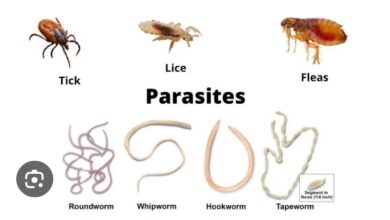Brucellosis:”Uncover the Shocking Truth About Brucellosis: The Hidden Pandemic Affecting Our Animals!”
How Animals get Infected with Brucellosis disease

Here’s a more detailed overview of brucellosis in animals, including its causes, symptoms by species, transmission, economic impact, diagnosis, treatment, prevention, and public health relevance:
What Is Brucellosis?
Brucellosis is an infectious disease caused by Brucella bacteria. It mainly affects the reproductive system of animals and can lead to significant economic losses in livestock farming due to infertility, abortions, and reduced milk production.

How Animals Get Infected
- Ingestion: Animals often become infected when they eat or drink something contaminated with Brucella bacteria—such as aborted fetuses, placenta, or fluids from infected animals.
- Direct Contact: The bacteria can enter through the mucous membranes (eyes, nose, mouth) or through broken skin when animals touch infected materials.
- Reproductive Route:
- Mating: Infected males can transmit the bacteria through semen.
- Birthing: Females shed large amounts of bacteria during abortion or birth, contaminating the environment.
- Environmental Persistence: Brucella bacteria can survive in cool, moist environments for weeks to months, increasing the risk of spread.
Why Brucellosis Spreads Easily in Animals
- Herd Living: Most livestock live in close quarters, so once one animal is infected, it spreads quickly.
- Lack of Sanitation: Poor hygiene practices make it easy for bacteria to move between animals.
- Wildlife Reservoirs: Some wild animals carry Brucella without symptoms and can infect domestic animals.
- Movement of Animals: Trading or moving infected animals between farms spreads the disease to new areas.
Effects on Animals
- Abortions, especially in the last trimester of pregnancy.
- Retained placenta, which can lead to further infections.
- Infertility or reduced breeding success, especially in males with infected reproductive organs.
- Decreased milk production, lowering the animal’s economic value.
- Lameness or swollen joints in chronic cases.

Read More About: Influenza Fever In Domestic Animals
Brucellosis in Animals – Detailed Explanation
1. Causative Agents (Brucella species):
Brucellosis is caused by different species of the Brucella bacterium, each with a preferred host:
- Brucella abortus – primarily infects cattle and bison.
- Brucella melitensis – affects goats and sheep; most pathogenic to humans.
- Brucella suis – infects pigs, reindeer, and hares.
- Brucella canis – found in dogs.
- Brucella ovis – infects rams, causing epididymitis.
These bacteria are intracellular pathogens, meaning they live inside host cells, making them harder for the immune system to clear and more difficult to treat.
2. Transmission of Brucellosis:
Brucella bacteria are shed in urine, milk, vaginal discharges, aborted fetuses, placenta, and other reproductive fluids. Animals can become infected by:
- Ingestion of contaminated food or water.
- Mucosal contact (mouth, eyes, genitals).
- Inhalation of aerosols in barns or during veterinary procedures.
- Venereal transmission (especially in swine and dogs).
- Vertical transmission (from dam to fetus via placenta).

3. Clinical Signs of Brucellosis(by Species):
Cattle (B. abortus):
- Late-term abortions
- Retained placenta
- Decreased milk yield
- Orchitis in bulls
- Arthritis in chronic cases
Goats & Sheep (B. melitensis):
- Abortion storms (up to 70% of pregnant females)
- Weak newborns
- Mastitis
- Arthritis
Pigs (B. suis):
- Infertility
- Orchitis and lameness
- Stillbirths or weak piglets
- Chronic infections in lymph nodes and reproductive organs
Dogs (B. canis):
- Abortion (typically around day 45-55 of pregnancy)
- Infertility in both sexes
- Orchitis, epididymitis
- Lymphadenopathy
- Diskospondylitis (inflammation of spinal discs)
4. Economic Impact:
- Loss of offspring (abortion)
- Decreased fertility
- Decreased milk production
- Restrictions on animal movement and trade
- Costs of testing, culling, and vaccination
5. Diagnosis of Brucellosis:
- Serological Tests:
- Rose Bengal Plate Test (RBPT) – quick screening
- Complement Fixation Test (CFT)
- ELISA (more specific and sensitive)
- Bacterial Culture: From aborted tissues or fluids (definitive but hazardous)
- PCR: Rapid and specific detection
- Milk Ring Test: For bulk milk samples in dairy herds
6. Treatment of Brucellosis:
- Treatment is usually discouraged in livestock due to:
- Poor success rates
- Risk of creating carrier animals
- Public health concerns
- Dogs and humans may be treated with long-term antibiotics, but relapse is common.

7. Prevention and Control Measuresof Brucellosis:
- Vaccination:
- Brucella abortus strain 19 or RB51 for cattle (RB51 preferred today)
- B. melitensis Rev 1 for small ruminants
- Test and cull strategies to remove infected animals
- Quarantine and testing of new or imported animals
- Pasteurization of milk to prevent zoonotic transmission
- Hygiene: Proper disposal of aborted materials and disinfection
- Surveillance: Regular testing programs and movement controls
8. Zoonotic Importance (Human Brucellosis):
Humans can contract brucellosis through:
- Consumption of unpasteurized dairy products
- Contact with infected animals (especially during birthing)
- Laboratory exposure (a known lab-acquired infection)
- Symptoms in humans:
- Undulating (waxing and waning) fever
- Sweating, joint pain, fatigue
- Hepatosplenomegaly
- Can become chronic if not treated
Global Distribution:
- Endemic in many developing countries, especially in the Mediterranean, Middle East, Asia, Africa, and Latin America.
- Eradicated or well-controlled in some developed countries through vaccination and test-and-slaughter programs.
Have you Heard More About: Foot and Mouth Disease
Learn More About Industrial Updates
Brucellosis is a contagious zoonotic disease caused by bacteria of the genus Brucella. It affects a wide range of domestic and wild animals around the world and can also infect humans (known as undulant fever or Malta fever).
Geographical Distribution (Where Brucellosis Occurs):
Brucellosis is worldwide, but it is more common in regions with limited veterinary infrastructure and where animal vaccination and control measures are poorly enforced:
- Endemic Regions:
- Mediterranean countries
- Middle East
- South and Central America
- Sub-Saharan Africa
- Asia, including India, China, and parts of Southeast Asia
- Some parts of Eastern Europe
- Controlled or Eradicated:
- In many developed countries like the United States, Canada, Australia, New Zealand, and Western Europe, brucellosis has been largely controlled or eradicated from livestock through testing, culling, and vaccination programs.
Animals Affected by Brucellosis:
Brucellosis affects many species of animals, with different Brucella species infecting specific hosts:
| Brucella Species | Primary Animal Hosts |
|---|---|
| Brucella abortus | Cattle (most common in bovines) |
| Brucella melitensis | Goats and sheep (most virulent for humans) |
| Brucella suis | Pigs (swine brucellosis) |
| Brucella canis | Dogs (canine brucellosis) |
| Brucella ovis | Sheep (affects rams’ fertility) |
| Brucella neotomae | Rodents (not known to affect humans) |
| Brucella pinnipedialis, B. ceti | Marine mammals (seals, dolphins, whales) |
Wildlife Reservoirs:
- Elk, bison, and wild boars can act as reservoirs, especially in places like the Greater Yellowstone Area in the USA.
- Wild ruminants, like deer and antelope, may be infected in endemic areas.
Symptoms in Animals:
- Abortion (especially late-term)
- Infertility
- Retained placenta
- Orchitis and epididymitis in males
- Decreased milk production
- Lameness or arthritis in chronic cases
Zoonotic Risk of Brucellosis:
- Humans can become infected through:
- Direct contact with infected animals
- Consumption of unpasteurized milk or dairy products
- Inhalation (in laboratories or slaughterhouses)
- Mucous membrane exposure
Summary:
Brucellosis occurs worldwide, especially in developing regions, and affects many domestic and wild animals, including cattle, sheep, goats, pigs, dogs, and wildlife. It is an important zoonosis, posing significant public health and economic threats.



